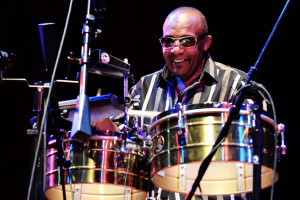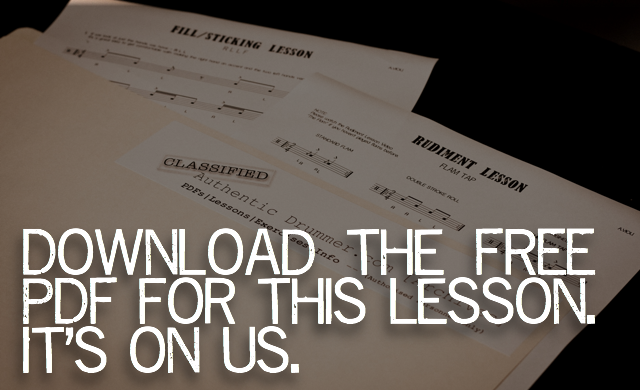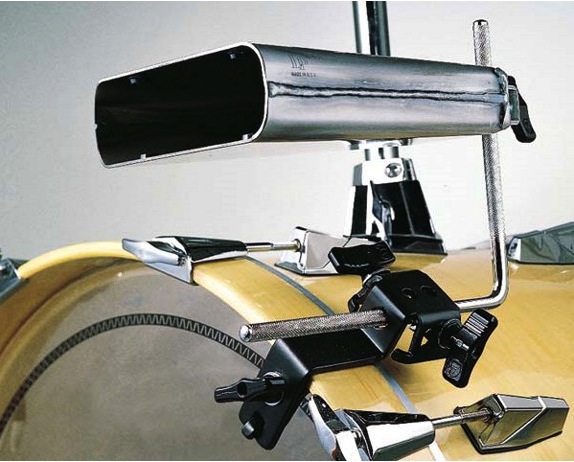Here we have our third instalment of a little series on SALSA. So far we’ve looked at the types of patterns you might play in the Verse of a tune. Now we look at when the band kicks up a gear – the Chorus. This is my favourite bit. It’s the moment when the crowd starts really going mental, dancing and cheering. There’s solos and all round good times. So it’s a perfect excuse for you to learn how to play the groove.
The actual ‘groove’ in question is known as SONGO. It’s a pattern devised and written especially for the drum set, unlike the Cascara/Clave patterns we’d looked at in parts 1 and 2. Songo was born through a famous Los Van Van percussionist and drummer ‘Changuito’.
 For the purposes of this lesson we’re looking the most famous incarnation of the Songo – it has a history. (See below for a link to do some more research).
For the purposes of this lesson we’re looking the most famous incarnation of the Songo – it has a history. (See below for a link to do some more research).
The Songo involves using a large cowbell called the Bongo Bell. It’s generally lower pitched and essentially outlines the downbeat. If there’s another percussionist in the band playing the Bongo bell pattern, you can play a simplified version of the Songo with the right hand on the hi-hat or the ride cymbal. Most of the time when I’ve played in Salsa bands, there’s not always enough cash available to have a dedicated Bongo Bell player so I’ve had to cover the part using a bell mounted on my bass drum (see main pic). The video lesson explains how to play the cowbell.
Taking things a step further, you can add the clave pattern you learned in the previous lessons in the left foot. It’s not always necessary though and for the majority of the time, I don’t need to do it. It is fun though.
To sum up these lessons, I must say a few crucial things.
1. This is the tip of the iceberg. These lessons are really a little crash course in getting your patterns happening on the drums but I would really advise to do as much research as you can, listen to Salsa and go see it being played live. I’ll be doing the same!
2. Learn the patterns well so you can improvise. Changuito says that you need to go with the flow of the music. When you have learned the patterns well, you’ll be able to start taking liberties with them and improvise little variations – phrases and statements that compliment the music.
3. Latin music is a language. I’m very much still learning the language. When I go to improvise or do fills, I must always be respectful of the music and make sure I’m playing appropriately for the style. Rock fills won’t fit etc.
I hope you got something out of these lessons!
Enjoy the vid.

Click here to download your exclusive PDF
Check out PART 1 of this series here
Check out PART 2 of this series here
If you’re interested in learning more about the history of Songo, check out this Changuito video – Documental La Historia Del Songo Changuito


Hey Adrian, first of all thanks for the very informative videos and sheet music. I am a drummer very interested in Salsa drumming, i learnt the foundation years ago but want to get more into it now. Unfortunately i have picked up a few bad habits and will now have to unlearn them to relearn them properly. Anyway i just had a question regarding the Clave pattern played on the rim shot. When i learnt the whole beat i started playing the clave pattern starting with the reverse of what you have showed in your video, so i was wondering is there a correct way to start? (the one you showed where the patterm goes x x, x x x) and when would you reverse the pattern? Does it matter which you start with or when you change it? Thanks again, great videos and instruction. PS: are you in OZ?
Hi Dan,
Scuse my delayed reply to this!
It’s TOTALLY cool to reverse these patterns. Absolutely. It happens all the time because the music will dictate which way the clave works – as a 2-3 or a 3-2 as you mentioned. So go nuts and make sure you can play both ways for sure!
So great to hear you got something out of this lesson. Keep in touch.
cheers!
Hi Adrian
Love your lessons!
Could you help decipher what Changuito is doing in a particular example he is showing in the video ‘Documental Historia Del Songa Changuito”. The slow motion starts at 15:43; it counts through ok but I’m not sure about the repeating section just after beat 4 +. Maybe a silent beat 1? Appreciate any help.
i